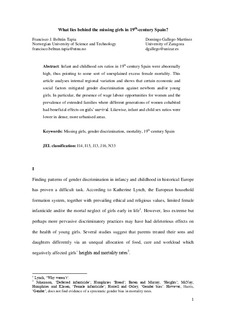| dc.contributor.author | Beltrán Tapia, Francisco Javier | |
| dc.contributor.author | Gallego-Martínez, Domingo | |
| dc.date.accessioned | 2019-04-01T10:23:04Z | |
| dc.date.available | 2019-04-01T10:23:04Z | |
| dc.date.created | 2018-08-10T13:25:01Z | |
| dc.date.issued | 2018 | |
| dc.identifier.citation | The Economic History Review. 2018, 1-19. | nb_NO |
| dc.identifier.issn | 0013-0117 | |
| dc.identifier.uri | http://hdl.handle.net/11250/2592660 | |
| dc.description.abstract | Infant and childhood sex ratios in nineteenth‐century Spain were abnormally high, thus pointing to some sort of unexplained excess female mortality. This article analyses internal regional variation and shows that certain economic and social factors mitigated gender discrimination against newborn and/or young girls. In particular, the presence of wage labour opportunities for women and the prevalence of extended families in which different generations of women cohabited had beneficial effects on girls’ survival. Likewise, infant and child sex ratios were lower in dense, more urbanized areas. | nb_NO |
| dc.language.iso | eng | nb_NO |
| dc.publisher | Wiley | nb_NO |
| dc.title | What explains the missing girls in 19th-century Spain? | nb_NO |
| dc.type | Journal article | nb_NO |
| dc.type | Peer reviewed | nb_NO |
| dc.description.version | acceptedVersion | nb_NO |
| dc.source.pagenumber | 1-19 | nb_NO |
| dc.source.journal | The Economic History Review | nb_NO |
| dc.identifier.doi | 10.1111/ehr.12772 | |
| dc.identifier.cristin | 1601005 | |
| dc.description.localcode | Locked until 6.9.2020 due to copyright restrictions. This is the peer reviewed version of an article, which has been published in final form at [https://doi.org/10.1111/ehr.12772]. This article may be used for non-commercial purposes in accordance with Wiley Terms and Conditions for Self-Archiving. | nb_NO |
| cristin.unitcode | 194,62,65,0 | |
| cristin.unitname | Institutt for historiske studier | |
| cristin.ispublished | true | |
| cristin.fulltext | original | |
| cristin.qualitycode | 2 | |
